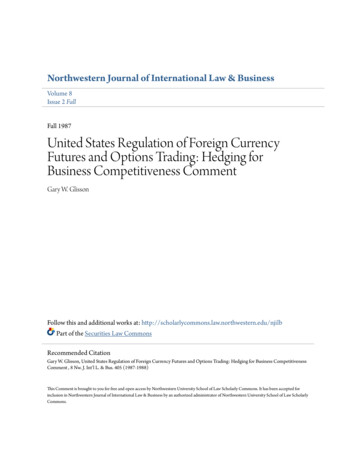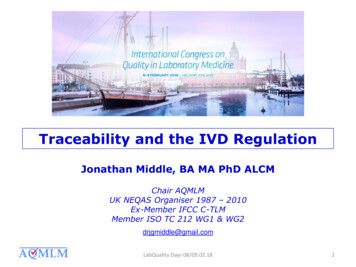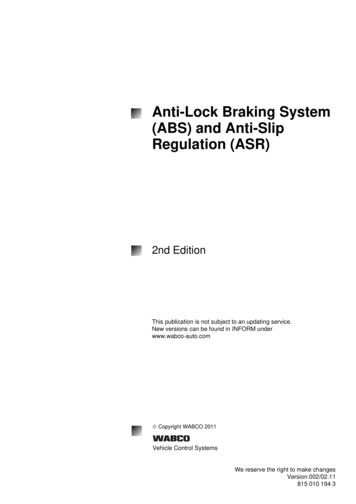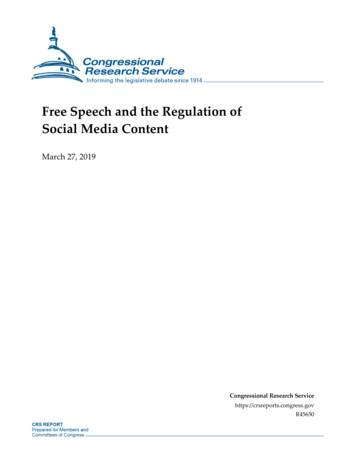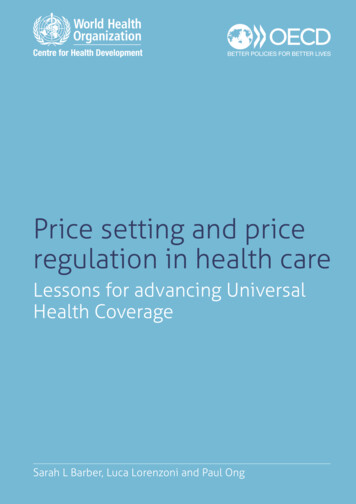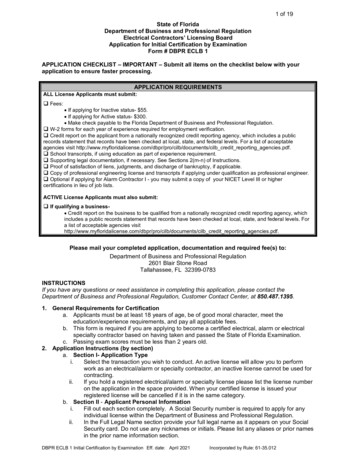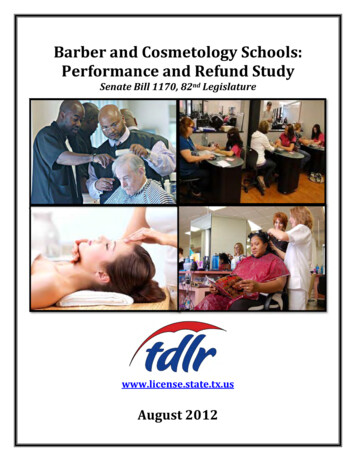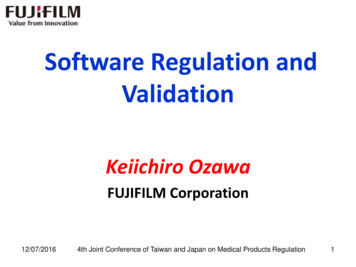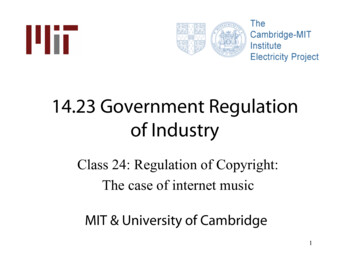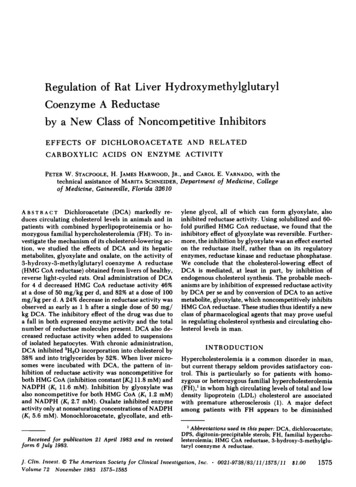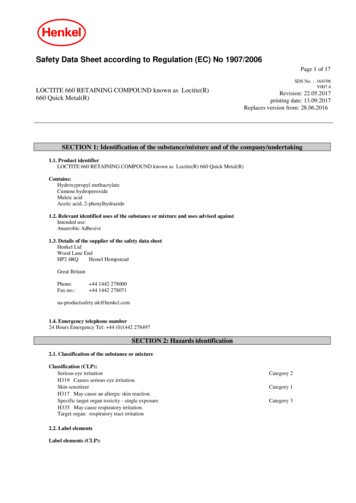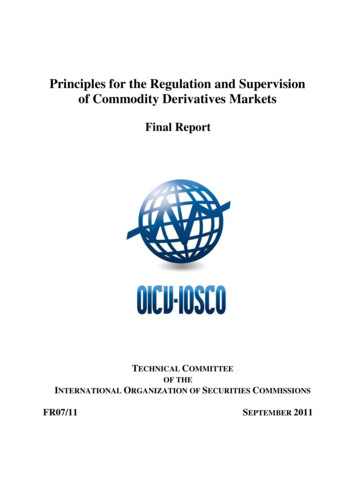
Transcription
Principles for the Regulation and Supervisionof Commodity Derivatives MarketsFinal ReportTECHNICAL COMMITTEEOF THEINTERNATIONAL ORGANIZATION OF SECURITIES COMMISSIONSFR07/11SEPTEMBER 2011
Copies are available from:The International Organization of Securities Commissions website www.iosco.org International Organization of Securities Commissions 2011. All rights reserved. Briefexcerpts may be reproduced or translated provided the source is stated.ii
ContentsChapterPage1Introduction5A. Prior Task Force Work5B. Principles Build Upon and Expand the Tokyo Communiqué 6C. BenchmarksEvolving Markets and Legislation Prompt the Need for Expanded 7Principles2Statement of IntentA. Authority, Process and Level of SupervisionB. Applicable Commodity Derivatives ContractsC. Other Structural Measures111111133Principles for the Design and/or review of Physical CommodityDerivatives ContractsA. IntroductionB. Contract Design Principles144Principles for the Surveillance of Commodity Derivatives MarketsA. IntroductionB. Principles2626275Principles to Address Disorderly MarketsA. IntroductionB. Principles3939406Principles for Enforcement and Information SharingA. IntroductionB. Principles4747477Principles for Enhancing Price Discovery on Commodity Derivatives 58MarketsA. Introduction58B. Principles588Conclusion62Appendix A - Summary of the PrinciplesAppendix B - Glossary of TermsAppendix C – IOSCO Technical Committee Task Force on CommodityFutures Markets637175iii1415
iv
Chapter 1 IntroductionThis Report has been prepared by the Task Force on Commodity Futures Markets (TaskForce)1 of the International Organization of Securities Commissions (IOSCO). The Reportresponds to the request by the G202 at its November 2010 summit in Seoul, Korea for furtherwork on regulation and supervision of commodity derivatives markets.3This work has been emphasized repeatedly by the G20. At its Paris meeting in February2011, the G20 finance ministers and central bank governors stated that they looked forwardto receiving IOSCO‟s recommendations “on regulation and supervision of commodityderivatives markets notably to strengthen transparency and address market abuse.”4Continued price pressures on commodities led the G20 Ministers at their meeting inWashington, D.C. in April 2011 to stress “the need for participants on commodity derivativesmarkets to be subject to appropriate regulation and supervision.5 The G20 Ministersreiterated their call “for enhanced transparency in both cash and derivatives markets aspreviously recommended by IOSCO” and “asked IOSCO to finalize, by September, itsrecommendations on regulation and supervision in this area especially to address marketabuses and manipulation, such as through position management powers, including theauthority to set ex-ante position limits where appropriate, among other powers ofintervention.”A.Prior Task Force WorkThese Principles should be read in the context of the ongoing work of the Task Force since itwas created by the IOSCO Technical Committee in September 2008 in response to global12The IOSCO Task Force on Commodity Futures Markets is co-chaired by the Commodity FuturesTrading Commission (United States) and the Financial Services Authority (United Kingdom) and thefollowing IOSCO members participated in the Task Force: Australian Securities and InvestmentsCommission, Comissão de Valores Mobiliários (Brazil); Alberta Securities Commission (Canada,Alberta); Ontario Securities Commission (Canada, Ontario); Autorité des marchés financiers (Canada,Quebec); China Securities Regulatory Commission (China); Dubai Financial Services Authority(Dubai); Autorité des marchés financiers (France), Bundesanstalt für Finanzdienstleistungsaufsicht(Germany), Securities and Futures Commission (Hong Kong), Forward Markets Commission (India);Commissione Nazionale per le Società e la Borsa (Italy), Financial Services Agency (Japan); Ministryof Agriculture Forestry and Fisheries (Japan); Ministry of Economy, Trade and Industry (Japan);Finanstilsynet (Norway), Monetary Authority of Singapore (Singapore); Capital Market Authority(Saudi Arabia); and Swiss Financial Market Supervisory Authority FINMA (Switzerland).The Group of Twenty (G20) Finance Ministers and Central Bank Governors was established in 1999 tobring together systemically important industrialized and developing economies to discuss key issues inthe global economy. The inaugural meeting of the G20 took place in Berlin, on December 15-16, 1999,hosted by German and Canadian finance ministers. http://www.g20.org/about index.aspx3See the G20 Seoul Summit Leaders’ Declaration (November 11-12, 2010). “Further work on regulationand supervision of commodity derivative markets: We called especially on IOSCO‟s taskforce oncommodity futures markets to report to the FSB for consideration of next steps in April 2011 on itsimportant work”, available at http://www.g20.org/Documents2010/11/seoulsummit declaration.pdf.4See Communiqué Meeting of Finance Ministers and Central Bank Governors, Paris, 18-19 February2011, available at http://www.g20.org/Documents2011/02/COMMUNIQUE-G20 MGM%20 1819 February 2011.pdf5See Communiqué Meeting of Finance Ministers and Central Bank Governors, Washington, DC, 14-15April 2011, available at pdf5
concerns, including those voiced by the G-8 Finance Ministers, concerning oil pricevolatility. Responding to these concerns, IOSCO issued a report in March 2009 6 containingrecommendations for improving commodity derivative regulation by securities and futuresregulators. The G20 Leaders endorsed these March 2009 recommendations in theirSeptember 2009 Pittsburgh Leaders‟ Statement, and called on the Task Force to collect moreoil market data and requested further recommendations on ways to reduce volatility in energyprices. That work stream resulted in reports by the Task Force to the G20 in June andNovember 2010, respectively, a report to the IOSCO Technical Committee in June 2010, anda report to the Financial Stability Board in April 2011.7 More recently, G20 AgricultureMinisters committed to share reliable data on agricultural markets in order to increase marketinformation and transparency; they asked for an enhanced collaboration between physical andfinancial regulators8 and invited the IOSCO Task Force to make concrete recommendationsin their forthcoming report in order to ensure a better functioning of, and more transparent,agricultural financial markets9.B.These Principles Build Upon and Expand the Tokyo Communiqué BenchmarksThe Task Force took as its starting point the benchmarks for contract design, marketsurveillance and information sharing that were set out in the Tokyo Communiqué in 1997.106See Task Force on Commodity Futures Markets, Report of the Technical Committee of IOSCO, March2009 available at 5.pdf.7See ibid.See OR01/11 Task Force on Commodity Futures Markets Report to the Financial Stability Board,Report of the Technical Committee of IOSCO 15 April 2011, available 352.pdf;See OR08/10 Task Force on Commodity Futures Markets Report to the G-20, Report of the TechnicalCommittee of IOSCO, 1 November 2010), available 340.pdf;See Task Force on Commodity Futures Markets Report to the G20, Report of the Technical Committeeof IOSCO, 23 June 2010, available at 4.pdf; andSee Task Force on Commodity Futures Markets Survey, Report of the Technical Committee of IOSCO,23 June 2010, available at 5.pdf.8The G20 Agriculture Ministers declaration “Action Plan for Food price volatility and agriculture”,Paris, 22-23 June 2011 available at http://agriculture.gouv.fr/IMG/pdf/2011-06-23 - Action Plan VFinale.pdf: “We decide to launch the Agricultural Market Information System (AMIS) in order toencourage major players on the agri-food markets to share data, to enhance existing informationsystems, to promote greater shared understanding of food price developments We emphasize thatAMIS will enable financial actors and market regulators to be better informed of the fundamentals ofphysical markets. A better collaboration between authorities, regulators and bodies responsible foragriculture physical and financial markets will improve regulation and supervision of markets.9Ibid: “We welcome the forthcoming work of International Organization of Securities Commissions(IOSCO) based on the set of concrete measures mentioned in its report to ensure a better functioningand more transparent agricultural financial markets (including over-the-counter derivatives), to preventand to address market abuses, cross-market manipulations and disorderly markets”.10In November 1996, following the revelations of huge losses at Sumitomo and the related adverseeffects on the global copper markets, the CFTC and the UK Securities Investment Board, along withthe relevant Japanese authorities, the Ministry of International Trade and Industry (MITI) and theMinistry of Agriculture, Forestry and Fisheries (MAFF), co-sponsored an international regulators'conference in London on physical delivery markets in international commodities. The Londonconference focused on the special problems that physical delivery markets pose for regulators andconsidered how contract design, market surveillance and international information sharing can reduce6
The Tokyo Communiqué standards constituted the first set of internationally acceptedguidance for contract design and market surveillance and information sharing for physicalcommodity futures markets. The Tokyo Communiqué focused specifically on physicalcommodity futures markets because contracts that are based on an underlying tangiblecommodity, whether settled in cash or by delivery of a physical commodity, may havecharacteristics different from futures based on underlying financial instruments. This isparticularly the case where supply is limited.The Tokyo Communiqué guidance was intended to serve as a standard against which MarketAuthorities could voluntarily benchmark their own supervisory programs. IOSCO endorsedgenerally the Tokyo Communiqué on two occasions. In 1998, the IOSCO TechnicalCommittee reviewed the Tokyo Communiqué for the purpose of determining whether thesurveillance and design guidance could be applied to exchange-traded derivatives that are notbased on a physical underlying commodity. The Technical Committee endorsed generallythe usefulness of the contract design and surveillance guidance contained in the TokyoCommuniqué to all exchange-traded futures, options on futures and options contracts on alltypes of derivatives.11 The Technical Committee‟s 2009 report similarly concluded that theTokyo Communiqué “continues to provide a comprehensive guidance that can assist MarketAuthorities in building an effective market integrity program.”12C.Evolving Markets and Legislation Prompt the Need for Expanded PrinciplesNotwithstanding the continued applicability of the Tokyo Communiqué design, marketsurveillance and information sharing guidance, since 1997 Task Force members have addedto these areas of guidance to take into account their domestic supervisory experience andtheir judgments as to what broad policies are needed to respond to contemporary trends incommodity derivatives markets. These trends are related to the scale, speed and cross-bordernature of trading on contemporary commodity derivatives markets, regulators‟ experience inaddressing novel forms of market abuses, the focus by investors on commodities as an assetclass and concerns about the impact of those new investor classes on physical commodityprices, and the rapidly evolving regulation of over-the-counter (OTC) derivatives markets:the potential for, and assist in the management of, manipulation and other market disruptions. The 17countries participating in that meeting issued a Communiqué agreeing on certain basic Principles ofregulation and on a year-long work program.That effort culminated on October 30 and 31, 1997. Representatives of regulators from 16 jurisdictionsresponsible for supervising commodity futures markets participated in a conference in Tokyo, Japan,jointly chaired by the CFTC, the Japanese MITI and MAFF and the UK FSA, and announced thecompletion of the work program contained in the London Communiqué issued in November 1996. Atthe end of the meeting, the regulators issued a communiqué (the Tokyo Communiqué) which, amongother things, endorsed two guidance papers, one on best practices for the design and/or review ofcommodity contracts and another on market surveillance and information sharing. The guidancesrepresent the first occasion on which regulators responsible for overseeing commodity derivativesmarkets have agreed to international standards for the supervision of these markets. See a e/intl/tkyc.pdf11See The Application of the Tokyo Communiqué to Exchange-Traded Financial Derivatives Contracts,Report of the Technical Committee of IOSCO, September 1998, available 85.pdf.12See Task Force on Commodity Futures Markets, IOSCO, March 2009, p.14, fn 6.7
Electronic trading – Most derivatives exchanges are electronic, thus providing directaccess to participants that may be located anywhere on the globe. Trading may beguided automatically by algorithms and, depending on the strategy, at high frequencyin speeds measured in microseconds. The scale and speed of trading requiresurveillance authorities to monitor and analyze millions of transactions data daily inorder to detect possible abusive trading schemes.13 Effectiv
Appendix B - Glossary of Terms 71 . Futures Markets 75 . iv . 5 Chapter 1 Introduction This Report has been prepared by the Task Force on Commodity Futures Markets (Task Force)1 of the International Organization of Securities Commissions (IOSCO). The Report responds to the request by the G202 at its November 2010 summit in Seoul, Korea for further work on regulation and supervision of .
